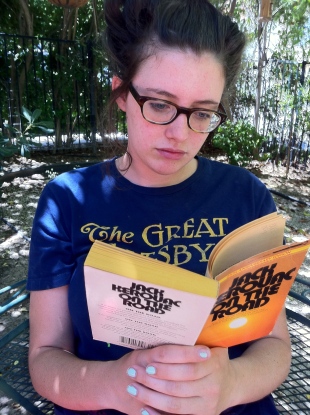copyright©donnaesgro
*
“In his blue gardens, men and girls went like moths among the whisperings and the champagne, and the stars.”
F. Scott Fitzgerald, The Great Gatsby
***
Imagine a roomful of high school Sophomores, their paperback Great Gatsby novels decorated with a rainbow of day glow highlighters.
They are preparing for this quiz:
In 3 -5 Sentences:
1. Describe Gatsby
2. Describe Daisy
3. Describe Gatsby and Daisy’s relationship
The tumultuous relationship between Gatsby and Daisy is a many layered, psychologically and socially complex one.
“No amount of fire or freshness can challenge what a man will store up in his ghostly heart.” F. Scott Fitzgerald, The Great Gatsby
The meaning behind the two protagonist’s relationship is a question that even experts in the field of modern American literature continue to ponder. And what does “Describe Gatsby” “Describe Daisy” mean? Physically? Emotionally? Intellectually? All in 3-5 sentences? These kinds of questions, for which annotation is supposed to help one prepare, cheapen the extraordinary beauty and depth that F. Scott Fitzgerald so elegantly crafted into The Great Gatsby – the quintessential 20th Century novel that most literary scholars believe is his best.
When reading classic literature, there is a bond that forms between writer and reader. The bond flows back and forth page after page as the reader becomes more immersed in the story. There is certainly no book without an author, but there is also no book without a reader. Without a reader a book is like the sound of a tree falling alone in the forest, or the sound of one hand clapping. The writer and reader fall deeply into a metaphysical conversation, a meeting of minds. Annotating – pausing, highlighting, writing question marks in the margins, etc., disrupts this. Imagine being in a deep, meaningful conversation with someone and interrupting every few minutes to write down pertinent points.
Classic literature enchants. We are meant to fall into the dream of the writer. If the reader doesn’t note all the metaphors, similes, and symbols, don’t worry, leave her free to fall in love with the author’s voice and she will go back to the story again and again-each time learning something new. We bring ourselves and all our assorted opinions, neurosis, and desires to the reading experience. An English teacher’s view of life is going to be very different than a fifteen year old’s. Let the children read in peace. What is the point of analyzing the character’s every move? Students will feel the character’s emotions, and isn’t that far better? And, what does it matter if one doesn’t perform well on a multiple-choice quiz? Has there ever been a multiple-choice quiz that enriches a literary experience?
English teachers ask their classes to annotate key points throughout an assigned book. How are the students to know what is key to the plot in the first few chapters? Let the book reveal its mysteries in its own time-as the author wished.The only reason to annotate a text is to prepare for an exam. The highlighter’s purpose is to lead the student to key characters and events that could pop up in a pop quiz. Sometimes a story is not unlocked until the very end. The author will hand you the key when he or she is ready. Tests are not for the students, they are for the teachers, to prove in black and white that they are teaching something-that their pupils are learning. That is why, so often, teachers “teach to the test” – a practice that is anti-learning, particularly in subjects that are open to interpretation, like literature. Tests on literature are “inside the box” tools, pre-thought out conclusions that demand a “correct” answer, although, often, there is none. How I understood Daisy in High School, and how I understand her now are quite different. Who is to say which interpretation is better? richer? more what the author intended? How can these kinds of responses, which are what reading is all about, be tested and graded for accuracy?
Throw away the highlighters, the flash cards, and the spark notes. Find some dappled shade and just read. Read for fun, read for enlightenment, read for joy, read for pleasure, read to journey to other lands and other centuries, read to learn-about yourself and all the wonders of the world, but don’t read to pass an exam.
“I didn’t know what to say. I felt like crying, Goddammit everybody in the world wants an explanation for your acts and for your very being.” Jack Kerouac, On the Road
